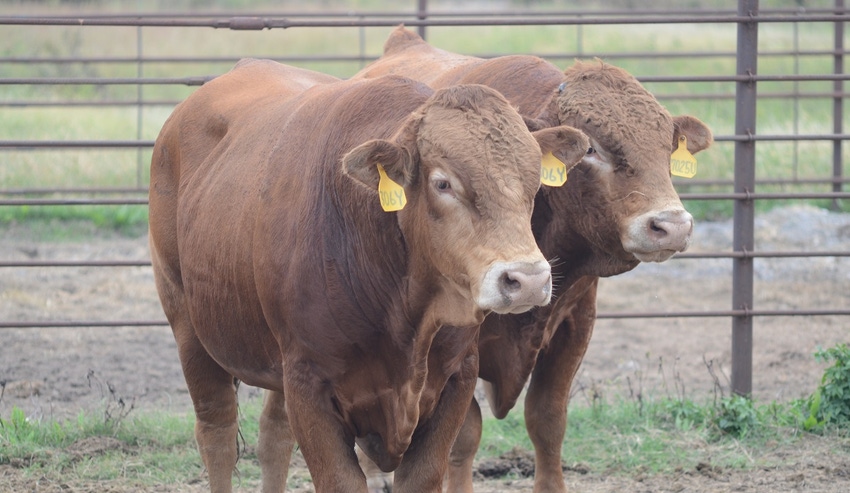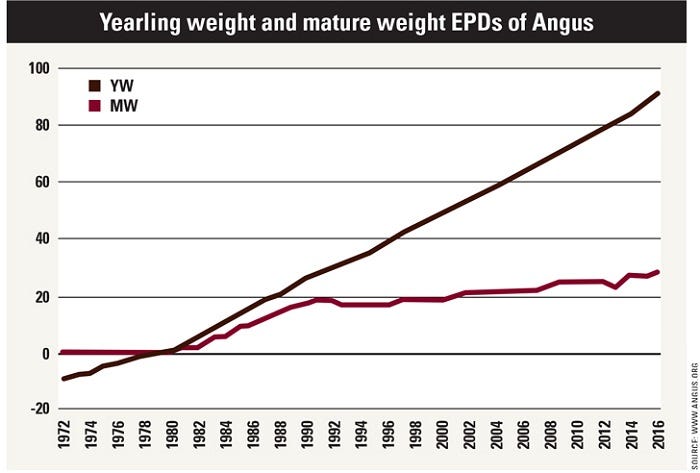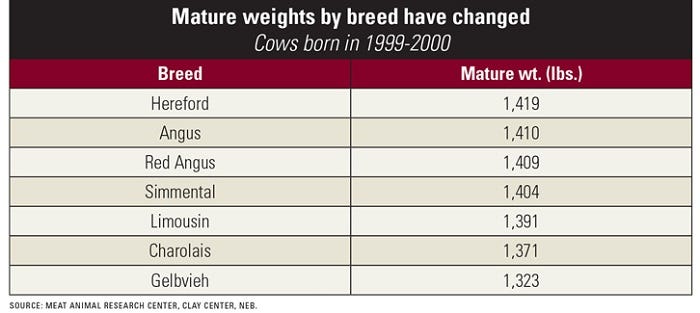March 12, 2018

By Dennis Fennewald
Sire selection for many producers seems fairly simple. Pick a bull that has an acceptable disposition and a low actual birth weight, will settle cycling cows in a short period (less than 45 days), is relatively “pretty,” and can be purchased as cheaply as possible.
While each of these characteristics can and do contribute to profit, there is a more accurate method. Let’s assume our goal is to make the most profit and we have two components:
1) Cows need to produce a marketable calf, profitably.
2) They must do so for many years.
Let’s explore some of the data needed and how we can combine all of this information into a single number, an index, to rank sires and aid in sire selection.
First we need the cost of feeding the cows. This is largely due to two factors: 1) mature size, adjusted to the same body condition score and 2) cost of milk. Although we would prefer mature weights (see graph of Angus mature weights compared with yearling weights), we can use yearling weights to predict mature weights as these have a high correlation (.76). We know the rule of thumb is for females to weigh about 65% of their mature weight at breeding and 85% at calving.

It is also important to understand the “old” breed characteristics do not apply and that continental breeds are no longer the largest.
Beef cows are not milked, but milk production is estimated from weaning weights of their progeny. The statistics used to obtain this information has been validated with multiple research projects, which show we can accurately group cows into different levels of milk production. Now we know the demand for energy by the cow in weight and milk and can calculate the cost of energy to maintain that cow. As an example, the American Angus Association values feed energy at $.095 per MCal NEm (megacalorie for net energy maintenance).
Figure income
Now that we have some of the costs, income can be determined at weaning or yearling time, as well as a finished carcass when selling on the rail. We can multiply these weights by a price (with any necessary slide) to get gross income. If we don’t have actual carcass data, we can estimate carcass weights from yearling weights, and use ultrasound data to estimate intramuscular fat, ribeye area and back fat. There is a limitation to using ultrasound, but many of the heaviest-used bulls will also have actual data from progeny.
Carcass weight is very important, but it is correlated to a large mature cow size. Thus, much of the benefit of a larger carcass weight is largely offset by having to maintain a larger cow.
Marbling can be very important and experts use historical data as well as trends to predict the benefit of increasing the percentage of Choice and Prime carcasses, as well as branded beef programs.
Differences in yield grade typically play a more minor role. Going back to the American Angus Association example, the index calculates the days on feed at 170 days. This is not optimum for all cattle but is probably optimum for most cattle.
There is one more major piece of information: Longevity.
Breed associations use the term "stayability," which is defined as the probability of a bull’s daughter to have a calf at the age of six given she had a calf at age two. The age of six is the estimated general age at which a cow has “paid back” all the expenses of the development cost of a heifer into a productive cow. This would be based on the sale of her fifth calf.
Some breed associations have a stayability EPD, such as Red Angus, Simmental, Gelbvieh, Limousin and Salers. Producers in these breeds must document each cow in the herd from the age of 2 to 6. Researchers know that the highest percentage of the females fail to rebreed after their first calf with the second most fall-out after the second calf. Thus, researchers don’t have to wait until the daughters are six years old to add information to the prediction.
There is a lot of variation within breeds for fertility. For example, the top 5% of the Red Angus breed has a stayability EPD of +15 and the bottom 5% of the Red Angus breed has a stayability EPD of +5. Let’s assume 60% of your females are still in production at age six. We would expect 65% of daughters sired by the top 5% of the Red Angus breed to still be in production, with only 55% of the daughters sired by the bottom 5% of the Red Angus breed. This is HUGE as 50% of the variation of a maternal index is based on stayability.

Now the index
It is possible to calculate profit at the ranch or at the feedlot/processor. It is also possible to calculate profit of the entire system. As you can imagine, sires are not equal in their ability to deliver profit. Some might do well at the ranch but not as well at the feedlot/processor and vice versa. The differences determine how these sires rank, which is their index.
Indexes are robust. Even as economic and production assumptions change, the net effect on the index is minimal, meaning the bulls generally rank the same. So now it is possible to rank the sires on their ability to deliver profit.
Some producers might want to select only bulls that rank in the top 1% for an index. This is not possible for everybody unless they can buy semen. So, some producers will buy bulls that rank lower, which is fine. Producers may want to avoid bulls that are “trait losers.” These bulls fall outside of an acceptable level of milk, growth, marbling and so forth.
Don’t forget to check out their disposition, hair coat and structure, as these can’t be fully incorporated into the index.
The conclusion is that sire selection is an art and a science. The good news is a selection index (the science) does a great job of giving appropriate weight to each EPD and accurately ranks sires for a specified outcome.
Two limitations to consider
There are two major caveats about this method of EPD selection that need to be discussed.
First is genotype-by-environment interactions (GxE). Sires may not rank the same in every environment for every trait. We might imagine some sires do well on fescue or at high altitude while others do not. This is not accounted for in the current EPDs and could change the ranking of sires for certain traits. Traits low in heritability, such as fertility, probably suffer more from GxE compared with growth and carcass traits. Thus, the stayability EPD and any index in which it plays a major role, could change the ranking of sires. This change in ranking could be a little or a lot.
Second, the indexes are based on cattle in the breed association database. The majority of cattle in the US will end up in a feedlot, so the indexes are geared toward this outcome. But this likely means the indexes are inappropriate for some other production models. Grass-based systems that market grass-fed cattle should use the indexes with caution and actually pay close attention to matching cattle to the environment by capping milk production and mature size at a lower level.
In Australia, the genetic evaluation is performed by a system called The cow bell curve. They do calculate an index for cattle destined for the feed lot (Heavy Grain Index) or grass-finished (Heavy Grass Index) and may provide a model to follow.
Grass versus grain problem
The bad news is there is more work to do for further accuracy.
There is a need for an index focused on grass-based production because the research is very limited in this regard. There is also a need to address GxE in beef cattle production. While this would be a positive move to increase the accuracy of sire selection, it also makes it more complicated for breed associations and producers. Breed associations would need to educate producers on the new indexes and how to select the indexes that fit their goals.
Dennis Fennewald, is an animal science professor at Tennessee Tech University in Cookeville, Tennessee. He can be reached at [email protected].
You May Also Like




